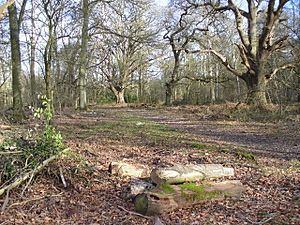Bookham Commons facts for kids
| Site of Special Scientific Interest | |
 |
|
| Area of Search | Surrey |
|---|---|
| Interest | Biological |
| Area | 154.7 hectares (382 acres) |
| Notification | 1985 |
| Location map | Magic Map |
Bookham Commons are two large areas of common land. They are located in Surrey, England. You can find them just north of the villages of Great Bookham and Little Bookham.
These commons cover about 154.7 hectares (382 acres). The two main parts are called Great Bookham Common and Little Bookham Common. A small group of homes, known as the Isle of Wight, is inside the commons. A track called Common Road leads to it. Little Bookham Common is to the south and west of this track. Great Bookham Common is to the east.
The National Trust owns both commons. They are a "Site of Special Scientific Interest" (SSSI). This means they are very important for nature. Many public footpaths and bridleways cross the site. You can also find special horse-riding trails here.
Contents
What Bookham Commons Are Like
The land at Bookham Commons sits on London Clay, which is a type of clay soil. This area has many different natural places. You can explore woodlands, areas of scrub (bushes and small trees), open grassland, and even ponds.
Woodlands and Open Areas
Woodlands cover about two-thirds of the commons. Most of these woods are old and full of large pedunculate oak trees. Many paths and trails cut through these woodlands.
Little Bookham Common has a mix of rough grassland and scrub. Much of this common can be quite wet. You might even spot some old holes from past activities, like gunpits or bomb craters. The open grassy areas are mostly covered in a plant called tufted hair-grass.
Ponds and Rivers
There are several woodland ponds scattered across the site. A small stream, which is a tributary of the River Mole, also flows through the commons.
Amazing Wildlife at Bookham Commons
Bookham Commons is very important for nature. This is why it's a Site of Special Scientific Interest (SSSI). It's special because of its unique plants, many different birds, and a huge variety of insects.
Special Plants
The woodlands here are home to a plant called Thin-spiked wood sedge. This plant is quite rare in Surrey. You can also find two types of roses, Rosa micrantha and Rosa stylosa, in the scrub areas. These roses are also scarce in Surrey.
The mosses in the woodland are very rich. One moss, Zygodon conoideus, is found in only two places in all of Surrey! In the grasslands of Little Bookham Common, you can see beautiful plants like the southern marsh-orchid. Other notable plants include pepper-saxifrage, spiked sedge, and adder’s-tongue fern.
The ponds and wet areas have three plants that are rare in Surrey. These are greater duckweed, fat duckweed, and thread-leaved water-crowfoot. There are also special wet grassland areas called "tall-herb fen" communities. Here, you might find two plants that are very rare in Surrey: the grass orange foxtail and eared willow.
Birds to Spot
Many interesting birds live and breed in the woodlands of Bookham Commons. Look out for the hawfinch, woodcock, and lesser spotted woodpecker. In the scrub areas, you might hear the nightingale or the grasshopper warbler.
Incredible Insects
Bookham Commons is famous for its huge number of insects. Scientists have recorded 611 types of beetles here! There are also 1140 kinds of flies, 146 different true bugs, and 201 types of spiders. If you love flying insects, you'll find 17 kinds of dragonflies and over 300 types of butterflies and moths.
Dead oak trees are very important for some beetles. They provide homes for rare Surrey beetles like Nemadus colonoides and Aridius nodifer. Two types of moths found here, the toadflax brocade and the broad-bordered bee hawkmoth, are nationally rare.
This site is also well-known for the amazing purple emperor butterfly. Other rare butterflies you might see include the white-letter and purple hairstreaks, and the beautiful white admiral.

